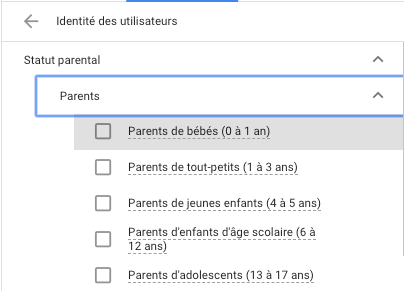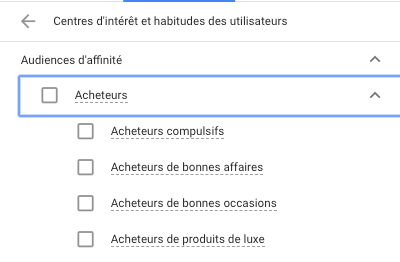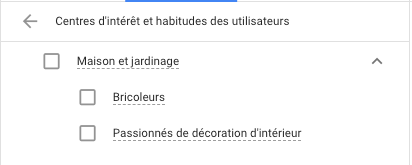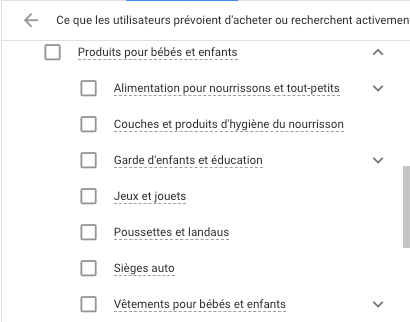When developing your business and e-commerce, you want to reach the widest possible audience to ensure your company’s growth and profitability. But to convert and build loyalty, you need to be able to address the right people with the right message , and not just the general public.
In the article below, we’ll review the principles of targeting and persona, essential for formulating your strategy for acquiring new customers and prospects. We’ll focus on the different audience optimization levers we can implement on your Google and Facebook campaigns.
Contents
Personas
Creativity and the seductive message
The customer journey
Exploiting audiences and retargeting
The different types of Audiences and their interests
Audience targeting levers are extremely important in managing campaigns on search engines, the Display advertising network and social networks.
Unlike physical stores, which have a conversion rate of 55%, e-merchant sites convert between 1% and 3% of visitors. So it’s essential to attract visitors with a clear interest in your products and services.
Persona: the key to understanding your customers
To optimize your approach and ensure successful communication, it’s essential to establish one or more customer profiles. These are known as personas.
To optimize your approach and ensure successful communication, it’s essential to establish one or more customer profiles. This is known as a persona.
There are many advantages to creating a persona:
1 Understand their problems and present the ideal solution
2 Identify your audience so you can target your Google campaigns and Facebook ads
3 Identify their habits so you can be present in the right place at the right time
The persona study enables you to put yourself in your audience’s shoes and find the right words.
How do you create a persona?
To identify the real problems and habits of your audience, you need to think deeply. Put yourself in the shoes of your ideal customer.
List their demographic and behavioural data, consumer habits, daily problems…
One possible approach is to create a typical day: from dawn to dusk, what does your ideal customer do?
There are several sites that allow you to create personas using just a few pieces of data: SurveyMonkey, UseForge, Up Close and Persona or Personapp.
Example: Here’s my simplified persona
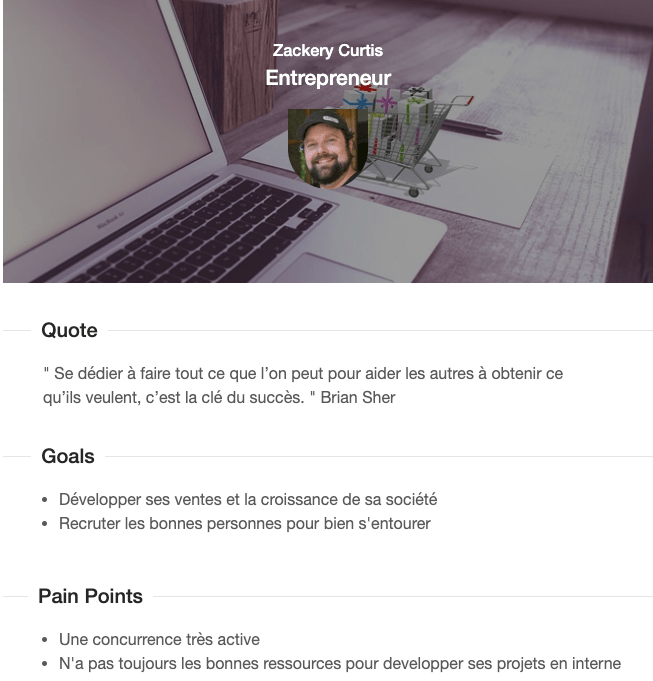
The process of setting up a persona is not necessarily a simple one, and can take time (brainstorming, teamwork, etc.).
On the other hand, once you’ve done it or redone it, it opens up new possibilities, new ideas for improving your offers and, of course, your acquisition campaigns.
It’s a very rich exercise that I recommend doing as a team.
See also: Building your audience on Facebook : foolproof techniques to implement
Creativity: Address your prospects with an attractive message
Convey the right message on the right medium, and maintain the high quality of your advertising.
Now that you know your customers better and want to guarantee a return on investment from your campaigns, you need to convey the right message on the right medium, and keep the quality of your advertising (image, video, content, text) at a high level.
In fact, targeting and persona work won’t be enough if the quality of the ads and advertising creatives isn’t up to scratch.
Nielsen Catalina Research study: 47% of ROI is attributed to the quality of advertising creative
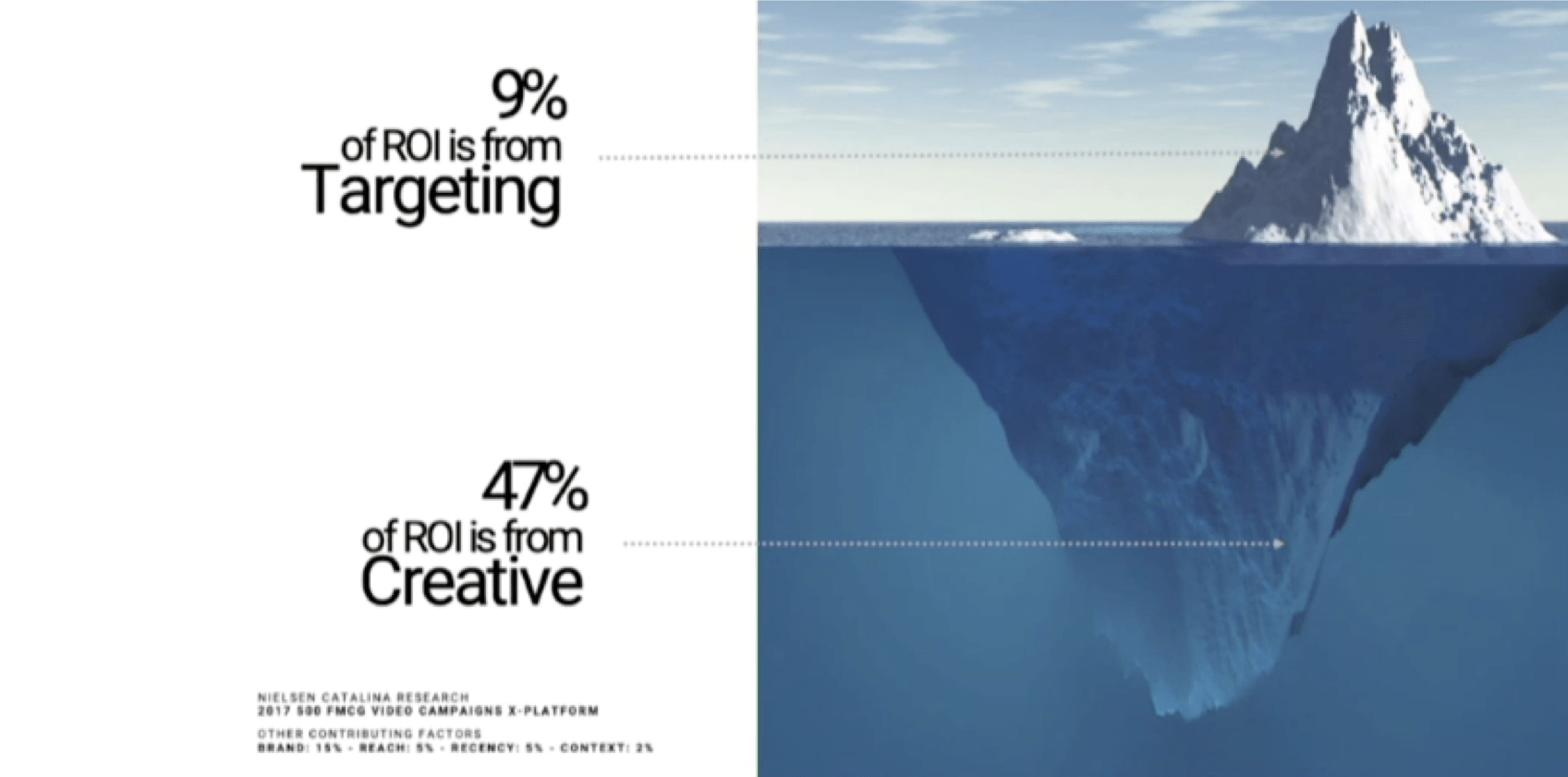
The quality of the images and the message is still a major factor in attracting new customers. What resonance will the ad have after it has been seen?
The Nielson study is clear: 47% of ROI is attributed to the quality of the creative.
With the right design, we can ensure optimal distribution on the various channels: search engines, Display, social networks ….
See also: how to find the right themes to captivate your audience?
The customer journey and the purchasing decision
Towards an increasingly complex customer journey
Consumer behavior has evolved and become more complex in recent years.
10 years ago, a customer’s path to purchase was still relatively straightforward, but today there are many more interaction points before a purchase or conversion on your site.
You need to be seen in the right place, at the right time, with the right message.
This means delivering your ads across multiple formats and channels, and paying particular attention to performance, budget allocation and sales/conversion attribution analysis.
**See also: Dynamic campaigns and catalog distribution on Facebook
Before” customer journey :
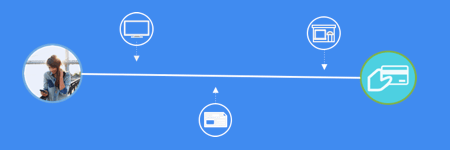
Today’s customer journey:
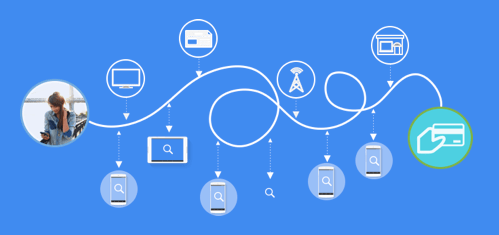
In fact, the evolution of cell phones and the number of screens per household are multiplying the points of contact with your customers.
“With nearly 5 billion mobile users worldwide, 6 screens per household
in France, and more than half of all searches carried out on Google in France and worldwide from a smartphone, the points of contact between consumers and brands have multiplied.”
Roland Duffau, Google
To better understand this evolution, Google and Facebook, as well as agencies like Adenlab, have invested heavily in Machine Learning (AI) technologies.
These learning algorithms enable marketers to make the most of the signals of intent left by Internet users as they navigate the web.
How to leverage audiences and retargeting (or remarketing) with Google Ads campaigns?
The different types of audiences offered by Google enable you to reach individuals along their decision-making paths.
Whether for traffic prediction, virtual assistants, fraud detection… Machine Learning is at the heart of Google Ads or Facebook Ads tools.
The use of Machine Learning algorithms today makes it possible to simplify complex tasks and focus on business objectives, to define qualified audiences, and thus let the algorithms determine who to engage as relevant prospects.
Below, we’ll illustrate the different types of audiences offered by Google, which enable us to reach individuals along their decision-making paths.
Use an audience-based approach in your Google Ads accounts
In recent years, one of the major challenges for Google Ads has been to break down the silos between ad formats and audiences:
In the past, when we wanted to target an audience with high purchase intent, we preferred the Google Shopping format (and sometimes the text format).
Today, with the right Audience settings, when we target “buyers”, we use Google Shopping, Text Ads, but above all what’s changing is that we also use the Display Network and YouTube!
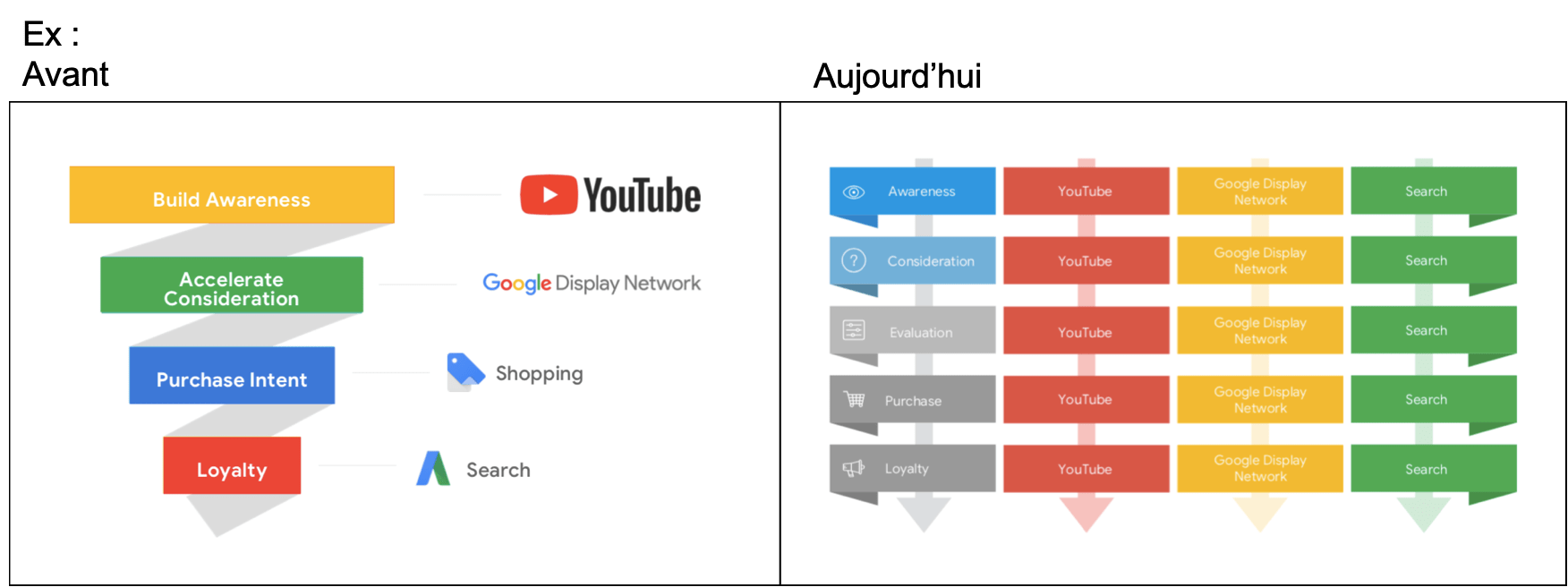
In terms of targeting, Google Ads technology has clearly evolved, enabling you to use many more formats and distribution channels to achieve your growth and ROI objectives.
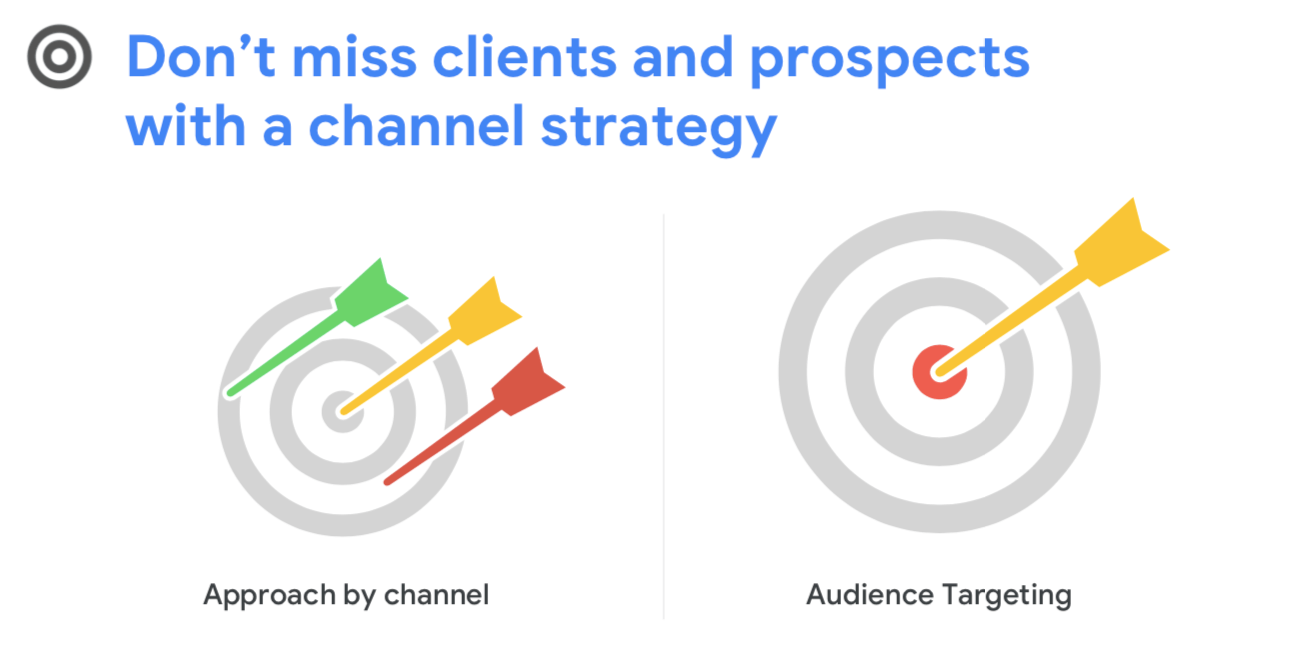
What are the main types of Audiences and how can they be used in your targeting strategy?
We leave “traces” everywhere on the web (and anonymously). Every day, we emit signals that are stored (thanks to cookies), analyzed and interpreted;
This makes it possible to understand and categorize behavior and people into different audiences.
Read more: Google Analytics secrets: Integrating specialized e-commerce audience lists
These audience categories can be used to manage campaigns on Google Ads or Facebook Ads. They enable us to target and prioritize a certain type of person according to our campaign objectives.
Ex: If our goal is to gain more visibility for my brand, I’ll target a demographic audience and an affinity audience.
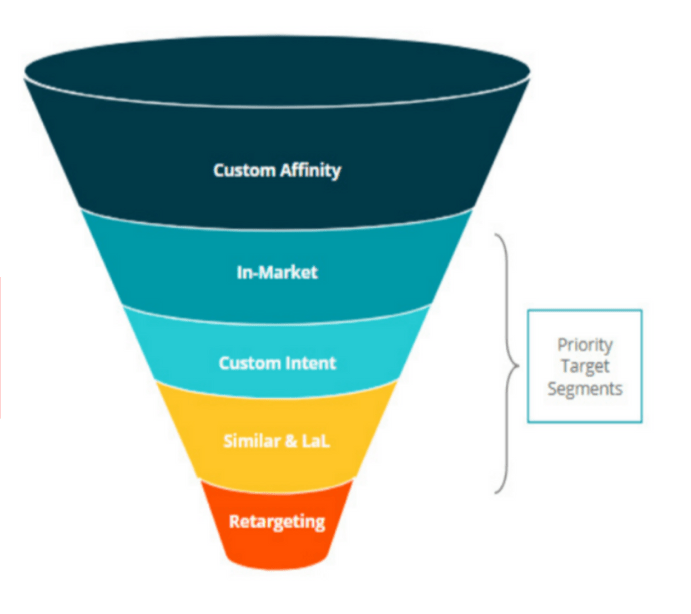
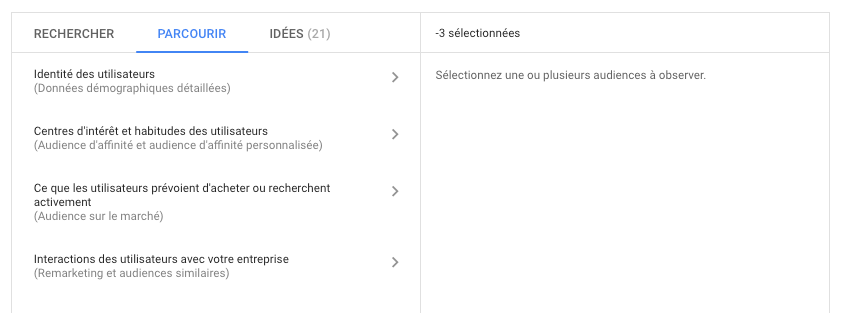
Audience demographics :
Generally used to target (or exclude) a large audience, they can be used to promote your company by segmenting users according to age, gender, income, profession or family composition (married or not, children…).
Example of a demographic audience selection in Google Ads: here Parental status
Here’s an example in Google Ads of a demographic audience selection by parental status.
See also: Audience exclusion, or how not to wear out your prospects?
Affinity Audiences and Personalized Affinity Audiences :
These audiences will enable you to target people who are close to your buyers and have been identified as having a real interest in your products and services; in fact, it’s their lifestyle, habits and interests that are analyzed.
Custom affinity audiences will allow you to combine additional parameters in Google Ads, such as keywords to target, Urls and site content, the types of places your prospects frequent, and the applications they’re likely to use.
Example of audience selection by buying behavior
Example of center of interest
Life event:
These audiences allow us to target people who are going through occasional events in their lives, such as weddings, births, but also moves…
And its audiences have multiple needs.
If we take the example of a birth, I can assure you that Google searches for “strollers”, “cots”, “do I make a good father” will be regular searches. Definitely worth implementing!
Market hearings :
With market audiences, you target people who are actively looking for your products and seriously considering buying them.
This is an audience you must activate in your campaigns, as it’s generally more ROI-intensive and even closer to the profile of your current customers and buyers.
Similar audiences :
As the name suggests, similar audiences target people whose behavior is very similar to that of your existing customers;
These audience lists are updated in real time! And your ads will be shown to people who have something in common with your ideal customers and prospects.
Selection of audiences similar/similar to your regular site traffic
Retargeting (or remarketing) audiences
Re-targeting “known” audiences who have come to your site is often a winning strategy, and doesn’t require too much budgetary effort.
In fact, the people who have come to your site already have a relatively strong intention to buy, and above all, they know you.
However, not every visitor to your site has the same value: you need to segment and distinguish between visitors who have left without doing anything, and those who have abandoned their purchasing process and are therefore much more likely to convert on your site.
Audience Customer Match
To target and exclude this audience, you first need to import your e-mail database into Google Ads.
This audience will also be very useful for creating similar audiences.
Conclusion
These audience typologies are much the same for Facebook ads. As a result, a wide range of approaches can be devised to develop your sales:
- Target by interests
- Your competitor’s fans or your fans’ friends
- Age groups, professions, Facebook activities, geographical locations…
- Family status (children, couple, married): useful for advertising events such as Mother’s Day, Father’s Day or Valentine’s Day.
It’s not easy to exploit the full potential of audiences, and their parameters are often under-exploited by advertisers. However, before taking the plunge, we recommend an observation phase on Google Ads and Google Analytics.
Over a relatively short period of time (depending on the traffic of your campaigns) you can identify the audiences that best meet your objectives. This observation phase will enable you to refine your segmentations and subsequently optimize your visibility and budget allocation.
Don’t hesitate to consult us for your acquisition strategies and the implementation of audience strategies on Google and Facebook.
Our SEA Agency, certified Google Partner Premier and Facebook Ads, applies different methods and uses various automation tools to develop the accounts of E-Commerce customers.
We specialize in high-volume projects and work on catalogs with a large number of references.

